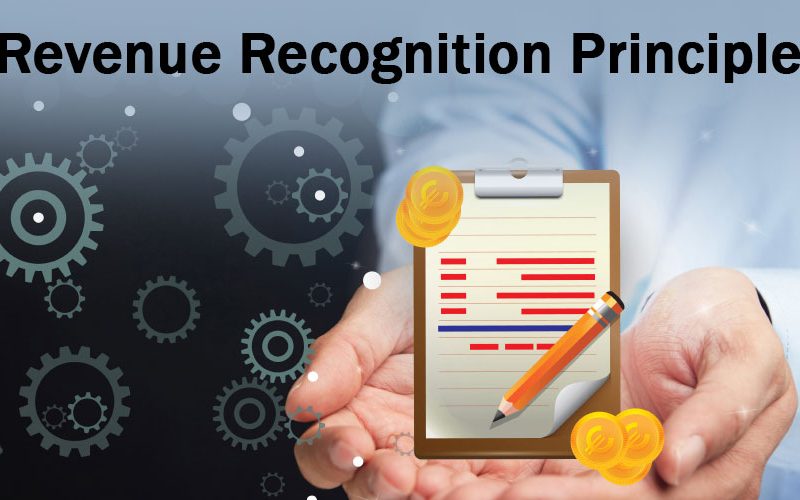If your company employs accrual accounting, you should be familiar with and comprehend the revenue recognition principle, also known as the revenue principle.
Why not spend a few minutes learning more about the revenue recognition principle, ASC 606 principle and why it is crucial to your company?
What is Revenue Recognition?
Revenue recognition is the process of determining when a company’s revenue has been earned.
If your company employs the cash basis of accounting, it’s simple: you make revenue when cash enters your cash register or bank account. It is not the same for organizations that employ accrual accounting. Revenue is only recognized on an accrual basis when it is earned.
One of the reasons we have Generally Accepted Accounting Principles is to help us understand when to recognize revenue (GAAP). GAAP specifies when and how to recognize revenue, as well as how to present it on your income statements.
You may have heard of International Financial Reporting Standards in addition to US GAAP (IFRS). Consider this revenue recognition system to be the metric version of GAAP; whereas the United States employs GAAP, the majority of the rest of the world utilizes IFRS. The International Accounting Standards Board is in charge of it (IASB).
So, what’s the distinction? In a nutshell, GAAP is a set of regulations that must be followed, whereas IFRS is a set of principles that must be followed. This standard’s most recent version is known as IFRS 15.
You don’t need to be concerned about the IFRS revenue recognition standard unless you operate outside of the United States. However, if you plan to expand beyond the limits of the United States, you should consult with a trained accountant about abiding by IFRS.
People outside your organization, such as investors, will frequently demand that your financial statements follow GAAP or IFRS. The fundamental reason for this is that they want you to identify revenue in a method that is familiar, standard, and not deceptive.
What is the Revenue Recognition Principle?
The revenue recognition principle remains the same regardless of the style of accounting used by your company.
According to the revenue recognition principle, revenue should be recognized when it is earned rather than when it is received. The notion of revenue recognition is part of accrual accounting, which means that when you produce an invoice for a customer for products or services, the amount of that invoice is recorded as revenue at that point, rather than when the money is received from the customer.
This is one of the primary distinctions between accrual and cash basis accounting because, in cash accounting, revenue is recognized when payment is received rather than when it is produced.
Principles of Revenue Recognition Under GAAP
The Financial Accounting Standards Board (FASB), which establishes U.S. GAAP standards, has established the following five revenue recognition principles:
- Determine the customer contract
- Determine the customer contract’s duties.
- Establish the transaction price.
- Allocate the transaction payment following the contract’s performance obligations.
- When the performance obligations are met, you can then recognize the revenue.
Revenue Recognition Requirements
The revenue recognition principle needs the double-entry accounting. Here are some more criteria to follow when it comes to the revenue recognition principle:
#1. There is an arrangement or agreement in place between your company and your customer.
This signifies that you have extended credit terms to your custome. Also, they have agreed to pay the invoice within the time frame specified to meet those requirements. For example, suppose you supply consulting services to Client A on a Net 30 basis. If Client A agrees to those terms, they promise to pay your invoice within 30 days of the invoice’s date.
#2. You have delivered or completed the goods or services that you are selling.
One of the mostsignificant aspects of the revenue recognition principle is that revenue is recognized and recorded when services are given or products are delivered. In essence, this signifies that your part of the deal is finished.
#3. Determine the Price.
When you offer your services or sell items to customers, you must give them the cost of those services or products, with the cost settled before recognizing revenue.
#4. The billed amount is receivable.
This is very easy, and it emphasizes the significance of thoroughly investigating consumers to evaluate their creditworthiness. Before offering credit terms to clients, you should be reasonably certain that you will be able to collect the sum due from them at a later date. Of course, this is not infallible because even well-vetted companies can pay their invoices late at times, but this should be the exception rather than the case.
#5. If you are unsure whether an invoice will be collected, it should not be recorded as revenue.
This is a difficult one because you are unlikely to give credit terms to a customer that you do not believe will be able to pay their bill. However, if this problem arises, you should postpone recognizing revenue until the bill is paid.
#6. If payment is received in advance for goods or services, revenue should be recorded only after the goods or services are delivered.
For example, if your company provides office cleaning services over $500 per month and your customer pays you $1,500 over the following three months, revenue would be recognized at $500 for the next three accounting cycles rather than being recognized in total for the current accounting cycle.
Examples of the Revenue Recognition Principle
Here are two simple instances of revenue recognition:
- Your company offers tax preparation services to a client. You send a copy of your invoice to your client when they have finished their tax return, and they have agreed to pay the charge within the next 30 days (net 30). Because the services have already been rendered, the revenue can be recognized immediately.
- You give your client monthly accounting services. That client pays you in advance for the entire year, with payment received on January 2nd. Remember that you may only recognize revenue as you generate it. Thus while you can recognize earned revenue for January, you must wait until February to recognize revenue for February, with revenue recognized each month through December as services are rendered.
How ASC 606 Revenue Recognition works
It’s difficult, but it all boils down to a five-step process that all businesses must follow to properly recognize revenue:
#1. Ensure that your contract with the consumer is clear.
Make certain that the agreement you sign with your customer clearly states what items or services you are providing and the payment terms for those goods or services.
#2. Determine the contract’s performance duties.
If your contract includes many goods or services, identify and separate them.
For example, if your subscription wine delivery service also provides online wine tasting instruction and customer support. Make sure to include those in your revenue recognition. Consider discounts, refunds, credits, bonuses, incentives, and so on.
#3. Calculate the entire transaction cost.
Make certain that the agreement you sign with your customer specifies exactly how much you will charge them for all of the items and services you will provide.
#4. Align the transaction price with the contract’s performance obligations.
Dissect the cost of each particular commodity or service you’re providing. Estimate the price of each good or service if you don’t have exact pricing.
#5. Recognize revenue as each distinct commodity or service is delivered.
Remember to only recognize revenue once you’ve delivered each good or service you separated and priced out in steps 1-4.
Will these New Revenue Recognition Principle have an Impact on my business?
ASC 606 revenue recognition principle will have a significant impact on the software as a service (SaaS) business, owing to how uneven and imprecise SaaS accounting was before the amendments.
SaaS services frequently bundle a variety of services under a single plan, and when the services they supply to the consumer is not always apparent. A great overview of how ASC 606 revenue recognition affects SaaS organizations can be found on ChartMogul.
However, SaaS organizations are not the only ones that will be impacted by ASC 606.
If you run a firm that takes payments from consumers in advance and your investors or lenders expect your financial records to be following GAAP, you should familiarize yourself with ASC 606.
So, what should I do next?
#1. Determine the significance of GAAP to your company.
You might not have to worry about any of this if you run a very tiny business with no lenders or investors.
However, if you are a startup seeking investment, a small firm seeking a bank loan, or a company wanting to sell its assets, you must record revenue following GAAP and ASC 606.
#2. Make sure you understand the new rules.
Review steps 1-5 of ASC 606 revenue recognition principle to ensure you understand how they affect the way you recognize revenue.
#3. Consult an expert.
If you’re not sure how ASC 606 revenue recognition principle affects your firm and can’t make sense of steps 1-5, consult an accountant, preferably someone with expertise in your area who has helped comparable organizations with ASC 606.
Revenue Recognition FAQ’s
Is deferred revenue a liability?
While receiving payment in advance of providing a service is a common business practice in the subscription industry, it’s vital to remember that deferred revenue is a liability, not an asset. This is due to the fact that the company still owes the client the service.
How long can you defer revenue?
When you and a client agree that the services will be given in the following tax year, the revenue can be delayed for only one year – the year in which the services are provided.
What are the three acceptable methods of recognizing expense?
The three methods of recognizing expenses are an association of cause and effect, systematic and rational allocation, and immediate recognition.






